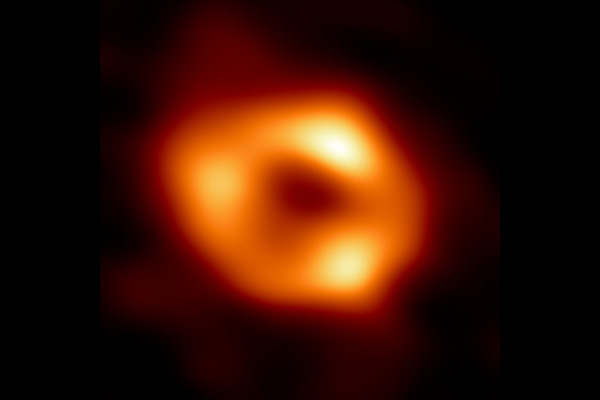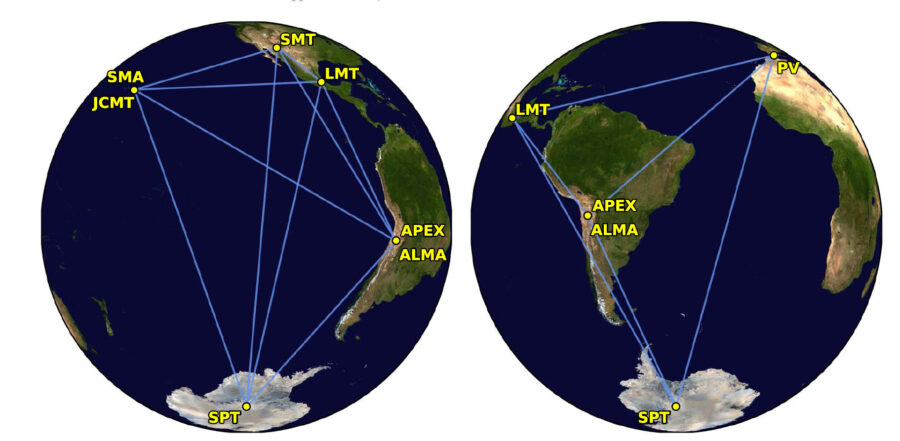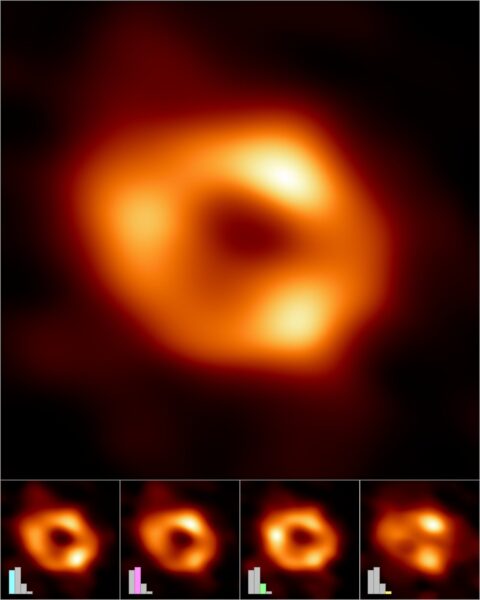Using a worldwide array of telescopes, the Event Horizon Telescope team has given us our first look at Sagittarius A*.
Today at multiple press conferences given simultaneously around the world, scientists with the Event Horizon Telescope project unveiled the first image of the black hole at the heart of our galaxy.
That black hole, Sagittarius A*, packs the mass of 4 million Suns into a region smaller than Mercury’s orbit around our star. Sgr A* is a “gentle giant” among black holes, grazing on a thin trickle of gas that reaches it from the winds of stars clustered in the galactic center. The infalling gas emits only a few hundred times as much energy as our Sun, so at 26,000 light-years away, Sgr A* is anything but bright.
But it’s also the closest supermassive black hole to Earth, and it’s our galaxy’s dark heart, making it an irresistible target. Astronomers have spent decades edging closer to the black hole’s event horizon, that infamous point of no return. They’ve watched stars whiz around on orbits that revealed the invisible object’s mass and caught flares as the gas trickle lit up.
Today, however, is the first time that we can see the black hole — or, rather, its silhouette. Just like the iconic 2019 image of the black hole at the center of the elliptical galaxy M87, Sgr A*’s image shows a fuzzy ring of light encircling a dark center. The light is radio emission and comes from electrons in the gas that swirls around the black hole; the dark center is where light comes too close to Sgr A* and plunges past the event horizon, never reaching us and leaving a “shadow” where the black hole is.
When EHT astrophysicist Feryal Özel (University of Arizona) unveiled Sgr A*’s image in D.C., the room burst into applause. This was the moment so many of us had waited for: We have finally met our black hole face to face.

EHT Collaboration
How to Take a Black Hole’s “Photo”
More than 300 people, working at 80 institutions in various countries, contributed to making this image a reality. Astronomers observed Sgr A* over five nights in April 2017, during the same observing run that brought us the M87* image. They used eight radio telescopes at six sites, spread from Arizona to the South Pole and Hawai‘i to Spain, to create a planet-size virtual telescope. This technique, called very long baseline interferometry (VLBI), combines the data from pairs of telescopes to achieve the resolution that would be possible if we had a radio dish as large as the distance between them.
The key with VLBI, however, is not just having a single big virtual dish. Each pair’s distance, or baseline, probes a different scale: Long baselines tell us about the fine structure of the object observed, whereas short baselines tell us about the big features. To even begin to fill in the image we’re trying to see, we need a variety of baselines, and more is definitely better.

The Event Horizon Telescope Collaboration / Astrophysical Journal Letters 930:L12, 2022 May 10
Reconstructing the shadow’s image required collecting incredible amounts of data — 3½ petabytes in this case, the equivalent of 100 million TikTok videos, quipped Vincent Fish (MIT Haystack Observatory) during the press conference. These data can’t simply be emailed (imagine that error message!). Instead, observers save the information to hard drives and physically fly them to sites in Germany and Massachusetts, where the data are correlated, perfectly synched within trillionths of a second.
Gas whips around Sgr A* in only a few minutes, compared to the days that gas takes to circuit M87*, which is roughly 1,500 times larger. That means that Sgr A* doesn’t sit patiently for its portrait: Its image is constantly changing, the thin, turbulent gas flow burbling and gurgling, Özel said. Furthermore, we look at Sgr A* through the dusty plane of the Milky Way, which blurs the image as though we were looking through frosted glass. All of this makes it difficult to take what amounts to an hours-long exposure.
The team used some of the most sophisticated computer algorithms ever written to reconstruct the image. Even so, Sgr A* proved daunting. As they had with M87*, members split into multiple teams, each using its own methods to reconstruct an image from the data. Last time, all the teams fairly quickly had an image, and they all agreed remarkably well. This time, the teams were stumped — many images showed a ring, but not all. It was so unclear what was going on that people didn’t even want to show their images, said computer scientist Katie Bouman (Caltech), who co-led the imaging effort. “That’s really what we have spent years trying to figure out,” she explained.
To solve the conundrum, scientists simulated different images and unleashed their algorithms on the mock data, to learn how their methods reacted to different situations. Finally, they were confident that indeed they do detect a ring, and always of the same size: about 50 microarcseconds wide, exactly as Einstein’s theory of gravity predicts.
What the reconstructed images don’t agree on is the bright knots dotting the ring. Knots are natural, due to the tangled magnetic fields threading a black hole’s tutu of hot gas. But the knots in the Sgr A* images move depending on which reconstruction you use, and they tend to line up along the directions with more telescopes, Özel warned. “We don’t trust the knots that much,” she said.

EHT Collaboration
Eerily Calm
As I sat listening to results I’ve waited more than a decade to see, something grabbed my attention: Sgr A* proved less variable than expected. EHT scientists had prepared a library of more than 5 million simulated images to compare with the results, combining possible scenarios with what previous observations have told us, such as the weak rate at which the black hole slurps down gas.
None of them matched how Sgr A* behaved.
During the five days the EHT observed, the gas flow was surprisingly calm. “To my mind, that is one of the most interesting things that we learned,” theorist Dimitrios Psaltis (University of Arizona) told me after the press conference.
Think of watching waves on the beach, he explains. Waves come in at the same speed, thanks to planet-scale gravitational tides, but how big the waves are depends on things like the wind and sea conditions that day. EHT astronomers expected big waves for Sgr A* — perhaps so big that they wouldn’t be able to take a decent long-exposure picture. “We predicted the storm, and we got a beautiful sunny day,” he says.
What that means, the team doesn’t know yet. It might be that magnetic fields in the gas aren’t as tangled as expected, or that they mix more gently than forecasted with the electrons that emit the radio waves. Nor do we know yet if this is a permanent or temporary condition. Future observations and analyses may reveal what the magnetic fields are doing.
A second notable result is that Sgr A* is lying on its side. Although the team hasn’t determined how fast the black hole spins, they can tell it is spinning and that we’re essentially looking down on Sgr A*’s head — the angle between our line of sight and the black hole’s rotation axis is less than 30°. Previous observations of hotspots around Sgr A*, using the GRAVITY instrument on the Very Large Telescope Interferometer in Chile, also indicated this arrangement.
This is not as surprising as you might think. Instinctively, we might expect that the black hole in the heart of a spiral galaxy would have its spin axis aligned with that of the galaxy. But a black hole’s orientation depends on how the black hole grew. Mergers with other black holes could cause a jumble of spin tilts, and for less active black holes like Sgr A* there’s no hefty gas stream to force the black hole into a particular orientation. Observations of feebly accreting black holes in distant spiral galaxies have also revealed a range of orientations, said Geoff Bower (Institute of Astronomy and Astrophysics, Academia Sinica, Taipei).
The Next Phase
This is just the beginning for the EHT. The team has yet to analyze data from subsequent observing campaigns, having spent all their time cracking the 2017 data’s complexities. They’re also ramping up for the next-generation Event Horizon Telescope (ngEHT), for which between now and 2030 they hope to add 10 more dishes scattered across the planet, boosting the number of baselines.
They’re also expanding beyond 230 GHz — the radio frequency of these images — to 345 GHz, which will improve images’ resolution by 50%. And perhaps most evocatively, they’re going to make movies, revealing how the black holes’ silhouettes change over time. M87*’s debut will come first, since it sits more quietly than Sgr A*. But in a decade, we may be watching videos of gas swirling around the black hole at the heart of our galaxy.
And when we do, what face will Sgr A* make at us?
Read the team’s six papers in the Astrophysical Journal Letters. You can also read our deep dive into the results from M87 in our September 2019 issue.
 2
2









Comments
Rod
May 12, 2022 at 8:22 pm
Very good here 🙂 The paper cited indicates an angular size ~ 50 mas so at 8 kpc, ~ 0.4 AU diameter. Using Schwarzschild radius and Sgr A* 4.3 million solar mass BH, diameter ~ 0.17 AU. Very nice.
You must be logged in to post a comment.
Bob-dBouncier
May 13, 2022 at 5:30 pm
So the center of the Milky Way is a humongous fidget spinner...
You must be logged in to post a comment.
You must be logged in to post a comment.